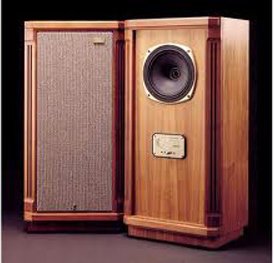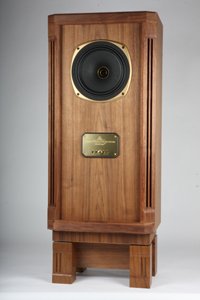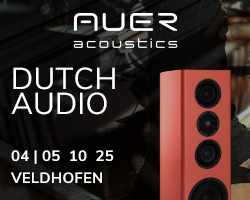Construction and Styling
These loudspeakers hail from the new range of Tannoy’s prestige series loudspeakers aimed at the higher end of the market, and employing not just the same technology as their predecessors of old in the use of dual concentric drivers, but also sharing a traditional cabinet design.
market, and employing not just the same technology as their predecessors of old in the use of dual concentric drivers, but also sharing a traditional cabinet design.
It’s probably worth starting with the aesthetics because it’s here that the new Prestige line stand head and shoulders above their more traditional ancestors. The design has been deliberately kept ye olde English where the ‘speakers seem if they ought to be fitted with brightly polished tan leather brogues for ‘speaker shoes, or dressed in tweed (hang on…the grill cloth is a little tweedy). It’s no small surprise that such traditional styling cues have been chosen as the main market seems mainly to be the Far East. It’s in markets such as Japan and Hong Kong where large floor standing Tannoys are prized possessions as part of the appeal remains the English country gentrification image as well as the traditional and much valued dual concentric loudspeaker design.
The odd thing is that the styling does in fact suit modern minimalist homes as much as it does Chesterfields and oak panelling, so wife acceptance factor (WAF) is likely to be very high. With the Turnberrys you get a box which stands 95cm tall by 46cm wide and 37cm deep, each box weighing in at a reasonably hefty 30Kgs. The front edges are crafted from solid European Walnut with left and right edging being twin through-fluted to act as the port vents for the cabinet, which is a neat and aesthetically pleasing design. The cabinet itself is a hefty and very solid construction of ¾ inch thick plywood/particle board with a European Walnut high quality veneer and it appears to be very well braced and very strong. They come with a few tubs of Tannoy branded wax polish, which whilst welcome does not make up for the fact that the woodwork from the factory is not all that well finished.
Removing the grill requires the use of a gold plated brass key to unlock the grill panel. Whilst this may appear gimmicky, it’s actually a good design as there’s no plastic bobbins to snap off and a rather sold locking mechanism which prevents little fingers removing the grills to get to the inviting drivers beneath!
For the review pair, I did also have a sneaky peak at the crossovers by removing the grills and then unscrewing the crossover housing which is fronted by a rather bling brass plate containing a treble energy variator (a posh screw which can be set into one of several holes for variations in treble energy response with +/_ 3dB from 1.3 KHz to 25KHz). The wiring is all high quality silver plated OFC and connections to the crossover board are via gold plated brass spade connectors. It is rather disappointing to note that on loudspeakers costing the thick end of £3500 new that Tannoy have decided to use plastic automotive-type block connectors for the drive unit connections themselves. It is a case of accountants having to target something to keep costs down, but better to add a hundred pounds or so to the price and do the job properly surely? Details like this matter and at this budget, quality matters.
Whilst we’re on cost, looking around at most loudspeakers in this price category, one rarely comes across a poorly finished product these days, even if piano black gloss finishes are rather too abundant for my own personal tastes. The Turnberrys were not particularly well finished externally. Whilst the timber is unquestionably high quality, little time has been spent in finishing the cabinets to a high standard. Other manufacturers such as Harbeth manage this without trouble, so it shouldn’t be too difficult for a little time to be invested here instead of giving the customer a tub of wax and some cloths to do the job themselves! However, some elbow grease and several coats of wax later and the speakers were starting to look like the high quality furniture that you should expect at the cost, with a lovely gentle sheen and the grain being brought out.
Driver Technology
So much for the looks and construction, what about the sound? Expectation bias will likely play a big part in any decision to buy Tannoy loudspeakers, any of them. As those who have or who have had the older Monitor Golds or HPD units might expect more of the same, whilst those who’ve never heard them or simply don’t like the older Tannoys may be put off before listening as opinions abound on the “Tannoy Sound”. Years ago, Tannoy had the means and the budget to produce some stunningly well engineered drivers and whilst it would simply be unaffordable to produce something like a higher power handling monitor Gold unit today, the DC drivers (split into two types: Tulip Waveguide and Pepper Pot) of today are still worthy of their hi-fidelity tag.
The Turnberrys come with the 10 inch DC Tulip Waveguide driver; this uses a sort of dual concentric brass coloured horn(s) within the main driver unit to obtain treble energy dispersion. Whilst this system is not ultimately as refined as the better (more expensive) Pepper Pot design, it nonetheless works very well. For those unfamiliar with Dual Concentric drivers from Tannoy, the idea is that you combine woofer and mid/tweeter into a single driver unit to obtain true point source imaging, the mid/tweeter using the curved bass driver and (in this case) an internal metal horn load the compression drivers used. The result is fabulous imaging. One thing that modern Tannoys do benefit from over the older units is in better engineered and higher quality crossover units, and this makes up a lot for the cost cutting in some of the driver technology used in the lower models.
Sound Quality
I was advised that straight out of the box, the Turnberrys needed 50 hours or so bedding in, but to be honest, they still sounded great from the word go. I had a range of amplifiers to try with them (more on this later). They were initially set up with a little toe-in about 500mm off the front wall and about a metre out from the corners although they didn’t seem too fussy where they sat to be honest. Initial impressions were of a well focused wall of sound with good imaging particularly front-to-back. Bass was a little dry straight off but there was plenty of punch there. The amp driving them to start with was a Croft pre/power combo with around 50 watts per channel which was more than plenty for the rated 93dB sensitivity.
Roll forwards 50 or so hours: Things had bedded in well after a week with more definition and wallop in the bass particularly noticeable and that superb imaging still set these loudspeakers apart from the crowd. Overall balance seemed very well integrated. I had been concerned that the urban myth of Tannoys needing super-tweeters would mean recessed treble but was rewarded with plenty of detail. These are not as forward as most these days and I do think that there is a tendency, which is as much about marketing as high fidelity, to deliberately lift the HF response on some loudspeakers to impress for first impressions. This is what I call the hifi fireworks trick, all tizz and sparkle but soon becomes fatiguing once said speakers are wired up at home. The Tannoys draw you into the music without this tizz but at no point was I left wanting for detail as the tiniest “ting” of a triangle being played (along with the decay) was noted on some orchestral music for example.
Where the first problems started to occur was in the upper mid frequencies, the home of the infamous “Tannoy Honk” which some of their DC speakers have gained a reputation for. Having heard Tannoys many times now, I was convinced that this honk was as much about cross-over issues and matching amplifiers as it was about the Tannoy design, although the Tulip Waveguide is arguably more prone to the “honk” than the more mannerly pepper pot sibling. This has been a bone of contention amongst enthusiasts for years and even now, arguments abound on this topic, so I set out to see whether refinement could be had and the effects of the over abundant upper mid energy reduced.
To cut a long story short, many different amplifiers were hooked up in turn, all with varying topology, some valve some SS and some hybrid. The best behaved was a push-pull Art Audio Quintet (modified with KT66’s in place of the usual EL34s) and surprisingly, a 25 year old SS amp (Ion Obelisk…a great little amp) did an admirable job as did the excellent LAR IA30 EL34 integrated amplifier. The Croft paring proved to put too much bass and upper mid energy into the speakers which was great for rock but not for much else (the culprit being the power amp which I’m sure that Croft could have re-worked if requested for the Tannoys). The biggest surprise was that for imaging and emotion along with a very neutral upper mid was that a Single Ended Mastersound amp came out tops, but only after the valves had some running in time as initial impressions weren’t as favourable across the bandwidth. The final audition was then done after spending several weeks with a Mastersound 845 Compact single ended valve amp kicking out some 30 watts in pure Class A.
I won’t claim that the honk had vanished altogether but it did become a complete non-issue as an overall balance was struck that was so musically involving that the music (whatever genre) took precedence with every disc and LP spin up. Now whilst the Turnberrys may have a fairly benign load and are an amp friendly 93dB sensitivity, there is obviously something happening either with impedance or phase angle exacerbated by the tulip waveguide somewhere about the crossover point from mid to treble. This in turn does mean that you have to be very careful which amplifier you partner with these loudspeakers in order to hear them at their best. Their best incidentally is very good indeed and certainly up there in dynamics, sound staging ability and bandwidth with the very best at a similar price range. What they have in spades is totally effortless scale which kicks in at very moderate levels so no need to play loud which if you have close neighbours or like to listen late at night is obviously an important consideration.
There will be some for whom no amount of dialogue will be ever be convinced about Tannoys as they will not have had the inclination or the means to listen on an extended basis with a variety of amplifiers. As stressed, with the right amplification, they are stunningly capable transducers whose strengths far outweigh their weaknesses in my book. It is a personal choice. I would say definitely audition if tempted but do NOT buy on the strength of a review  alone (as with anything else hifi). Certainly audition on the strength of a review because you may never get to appreciate what these are capable of otherwise. Be prepared for some amp box swapping shenanigans and what you end up with may very well be the very last set up you’ll ever want or need.
alone (as with anything else hifi). Certainly audition on the strength of a review because you may never get to appreciate what these are capable of otherwise. Be prepared for some amp box swapping shenanigans and what you end up with may very well be the very last set up you’ll ever want or need.
One thing to note is that whilst standing 95cm tall, these ‘speakers and their slightly smaller siblings, the Stirling SEs still require stands to ensure that the tweeter is at ear level (unless you have a very low sofa or listening chair). It does make a difference and a positive one at that. I was rewarded with better clarity and a slightly cleaner bass response by lifting the Turnberrys by around 7 or 8 inches and used the purpose made RFC stands (shown in the pictures) for this purpose.
Conclusions:
The Turnberry SE’s are a very fine loudspeaker for the price. The sound quality is very good, having effortless scale, good bass and excellent transient response along with truly superb imaging thanks largely to the point source driver design. Where they fall back slightly is that they are very amplifier fussy. Whilst almost all amplifiers of 25 to 30 watts output and above will work with them, and whilst valve amps tend to reward with a more silky smooth presentation, careful partnering is required to avoid exacerbation of the upper upper mid energy. Having said that, get the amplifier match right and you will be rewarded with a very musically engaging performance with just about any genre which draws you into the performance like few others. They are a great alternative to spending considerably more on buying an older set of reconditioned MG drivers and having new cross-overs and cabinets made up and they have higher power handling than the older units, able to handle amplifiers of up to 180 watts output.
Higher powered amps do tend to work better with these than flea powered valve amps. Forget using them with 2A3 or 300B single ended or PP amps because they simply won’t have the grip or dynamic capabilities with the Turnberrys. Any decent push-pull valve amp of 40 watts or more should work well, and powerful (for single ended anyway) SE amps of around 30 watts output are ideal although a very expensive alternative. Budget SS work very well too, and having used some 20 to 30 year old SS amps with them, they can be driven well on a tight budget. Aim for a SS amp of around 50 watts/channel upwards for best results if class A/B. Whatever you use, the caveat is try as many as you can because the Turnberrys respond differently depending not on wattage but on amp topology although it is fair to say amps which put out larger current work well. Due to the design of the driver, it is one of the few occasions where you may find that slightly less damping factor of the amp can work wonders, but again, experimentation is the key.
Whilst the Turnberrys may not sing quite as sweetly or as deeply as the more expensive Kensingtons (using the pepper pot drivers) get the amplification right and they will look like excellent value by comparison and not that far short on performance. The Tannoy 10 inch drivers are the pick of the bunch for me as they do seem to have more speed than the larger 15 inch models yet in large enough cabinets deliver a surprising bass wallop and superb imaging.
I will not give a “highly recommended” tag to these simply due to the fact that the finish from the factory, plus some of the components ought to be better specified for the price and due to the great care needed with amp matching. However, if you are curious, then rest assured that the Turnberrys, matched with an appropriate amp are well worth the cost and all of the effort. Hifi is something of a journey and it is fair to say that for many, these (and most certainly the Kensingtons) could be the last step in that journey simply due to their sonic strengths and their timeless styling.
Author – Paul
Want to read more hifi reviews?






































































































































































































You must be logged in to leave a reply.